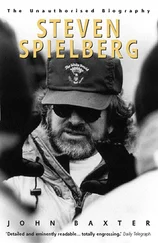JOHN BAXTER
To Marie-Dominique Moveable feast
Cover
Title Page
Dedication
Epigraph
1 The Emperor of the West
2 Modesto
3 An American Boy
4 Cars
5 Where Were You in ’62?
6 USC
7 Electronic Labyrinth
8 Big Boy Now
9 The March Up-Country
10 American Graffiti
11 The Road to the Stars
12 I am a White Room
13 For Sale: Universe, Once Used
14 ‘Put Some More Light on the Dog’
15 Saving Star Wars
16 Twerp Cinema
17 Leaving Los Angeles
18 Writing Raiders
19 The Empire Strikes Back
20 Raiders of the Lost Ark
21 Fortress Lucas
22 Snake Surprise
23 Howard the Duck
24 The Height of Failure
25 Indiana Jones and the Last Crusade
26 Back to the Future
Filmography
Bibliography
Index
Acknowledgments
About the Author
Notes
By the Same Author
Copyright
About the Publisher
There are times when reality becomes too complex for oral communication. But legend gives it a form by which it pervades the whole world.
The computer Alpha 60 in Alphaville , by Jean-Luc Godard
1 The Emperor of the West
The Man in the Panama Hat (years older now) removes the Cross of Coronado from Indy’s belt.
PANAMA HAT: This is the second time I’ve had to reclaim my property from you.
INDY: That belongs in a museum.
PANAMA HAT: So do you.
From Indiana Jones and the Last Crusade . Screenplay by Jeffrey Boam, from a story by Menno Meyjes and George Lucas
As he neared his sixtieth year, George Lucas sat in the shade on the red-brick patio of his home at Skywalker Ranch in Northern California and thought about destiny.
Almost without realizing it, he had become a legend – a man larger than life, magnified by his achievements, but dwarfed by them too. Over forty years, head down, brow furrowed, working every day and most of every night, ignoring discomfort and ill-health, banishing every distraction to the edge of his vision, he had created something remarkable. An empire. A fortune. A myth.
He was not a myth to himself. Only a megalomaniac takes his legend at face value. A sense of his ordinariness was part of the reason he’d succeeded. At first, the awe of his acolytes had puzzled him. Then he’d been amused, but irritated too; he’d been brought up to scorn self-advertisement and conceit.
But as one ages, adulation rests more comfortably on the shoulders. Occasionally, these days, he surrendered to the belief that perhaps he could really achieve anything on which he fixed his energy and instinct.
Other men, less able, less driven than he, paused before embarking on a project, and sometimes wondered, ‘Why am I doing this? What will be its effects, on me and on others?’ They pondered, worried, took advice.
In the beginning, Lucas had sometimes done that, but not lately. Myths don’t hesitate.
There was something presidential, even a touch imperial, in his certainty. Though it wasn’t something he confided to many people, he knew history. He’d read of Julius Caesar looking out on his empire and proclaiming, ‘I came, I saw, I conquered.’ He knew of Napoleon as a young officer surveying a world disordered by revolution and being seized by a vision of mankind united under a single rational mind. Above all, he understood Alexander the Great pausing at the end of his last campaign and weeping because there were no new worlds to conquer.
Yet he, a man less favored in his birth, less wealthy, less powerful, less educated, had achieved more than any of these men. He’d conquered not only this world, but other worlds besides. He was, in his way, master of the universe.
Or so his admirers said.
Was it true? He looked around for somebody to ask, and found only the smiling, alert faces of people anxious to do whatever he ordered, agree with whatever he said, set to work on anything he planned.
A legend is always alone.
On 4 July 1980, while Skywalker Ranch was still scrub and pasture, Lucas hosted his first cook-out on the site. There had been nothing much here in those days: just scrub, some cows, and a few deer which had become over the years the main reason for any stranger venturing this far north in Marin County. The spot where the grills were set up had once been occupied by banks of refrigerators to preserve the carcasses of game slaughtered by hunters.
Twenty-five years of construction and landscaping had transformed the old Bulltail Ranch. Anybody driving up from San Francisco along Route 101 and turning onto Lucas Valley Road at the exit marked ‘Nicasio’ found themselves passing through an expensive housing development, then twisting through an idyllic landscape of rivers and waterfalls. Discreetly, a shining wire fence paralleled the road, just out of sight in the woods. Signs every few yards warned that the fence was electrified – to keep in the deer and other livestock that roamed the estate, explained the custodians of the ranch, though everyone knew of George’s nervousness about strangers, and his fears of kidnap.
After eight miles, a sign so undemonstrative that you might well miss it unless you were looking led to a side road that wound through tall redwoods to a guardhouse. Security staff checked the visitors’ credentials against a list of people deemed persona non grata – ungrateful executives, sceptical critics, invasive journalists, technicians insufficiently respectful of Lucas or his managers. In one famous case, two special-effects technicians had been discovered after a cook-out, ‘drunk as skunks,’ according to one report, in that holy-of-holies, George’s private office. They joined the list of people ‘banned from the ranch’ – a phrase so much in currency within the effects community that one Los Angeles group took it as its business name.
Those who passed inspection were directed down the hill into the huge underground parking station, where their cars’ presence wouldn’t intrude on the rural calm. Any who remembered the ranch from the first cook-out didn’t recognise it now. A three-storied fin de siècle mansion clad in white clinker-built planks like a whaling ship, topped with shingled gables and fringed with wide verandahs, stared west across a wide artificial lake and landscaped grounds to a cluster of equally antique-looking buildings on the far side of the valley.
For centuries, European landowners had built ‘follies’ on their estates. One could have one’s own Roman ruins, with carefully shattered pillars, a picturesquely tumbled wall or two, some fragments of sculpture. Or a grotto in the Gothic style, its fountains decorated with old metalwork that might, if you didn’t look too closely, have been looted from some Etruscan tomb. Such buildings bought the owner an instant pedigree, an off-the-hook connection between a nouveau riche family and the ancient world.
Skywalker Ranch went one better. If anyone asked, staff recounted an invented history as carefully constructed as any screenplay. They were told that the property had been a monastery until a retired sea captain bought it in 1869. He built the Main House, which recalled the ‘cottages’ constructed on Newport, Rhode Island, by Vanderbilts and Whitneys at the turn of the century as summer retreats. The captain added a gatehouse the following year, and a stable. In 1880, he was supposed to have diversified into wine-making and built the large brick winery, which was given art moderne additions by a forward-looking descendant in 1934. In 1915, another innovative son erected a house spanning a brook on the estate, using the then-fashionable Arts and Crafts style pioneered by William Morris in the late nineteenth century. Later additions included the two-story library in polished redwood under a dome of art nouveau stained glass, its shelves housing a well-used and comprehensive reference collection.
Читать дальше












